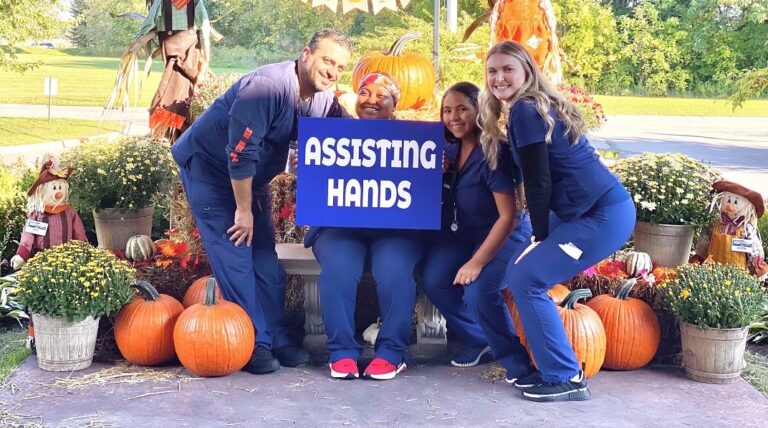135 ways we can help you provide caregiver services for you!
Let our home care providers and senior caregivers help you at home! We list the top 135 ways that we can help you or your loved ones!

Your care assistant can provide you or a loved one with assistance, including but not limited to the following areas:
Ways we can help:
- Sitter services
- Medication Reminders
- Scheduling appointments
- Actively participates and takes notes at a doctor appointment
- Follows up with family members in regards to appointments.
- Transportation
- Accompany on Walks
- Safety/Fall Protection
- Limited Transportation
- Accompany to Doctor Appointments
- Bathing
- Bed Making
- Companionship
- Dressing
- Dusting
- Eating
- Errands
- Grocery Shopping
- Grooming
- Hobbies
- Incontinence Care
- Laundry
- Meal Preparation
- Medication Reminders
- Mopping
- Oral Hygiene
- Organizing Incoming Mail
- Pet Care and Feeding
- Picking up Prescriptions
- Post Office Visits
- Recreational Activities
- Respite/Relief for Families
- Sweeping
- Taking out the Trash
- Toileting
- Transferring and Positioning
- Vacuuming
- Washing Dishes
- Walking and Mobility
- Companionship
- Errands
- Playing cards
- Pet Care
- Meal Planning
- Meal Preparation
- Supports nutritional programs created by other health care providers
- Grocery Shopping
- Baking
- Properly document Intake and output
- Encourages/Monitors fluid Intake
- Prepares meals following doctor’s orders. (Ex. Diabetic, low sodium, etc.
- Prepares and cleans feeding tubes and other feeding apparatus.
- Prepares liquid diet with/ without thickener.
- Maintains a safe environment in clients home
- Sweeping
- Mopping
- Dishes
- Clean/ wipe down cupboards
- Take out garbage
- Dusting
- Vacuuming
- Laundry
- Clean stovetop
- Clean out refrigerator
- Clean toilets
- Clean shower
- Clean Windows
- Organize cupboards
- Organize closets
- Shovel snow
- Spread salt
- Water indoor/ outdoor plants
- Dry Cleaning
- Change linens/ bedding
- Check and record vital signs
- Record medical notes and information
- Showering assistance
- Bed Bath
- Toileting assistance
- Change briefs
- Assist client with commode/ Urinal
- Catheter Care
- Assist with dressing
- Nail care (Hands)
- Paint nails
- Backrub
- Rub lotion on the client’s legs
- Wash hair
- Style hair
- Oral care
- Provides proper care for wounds under the supervision of a registered nurse.
- Promotes and implements a range of motion exercises under the supervision of a PT/ OT.
- Assist client while changing positions from sitting to standing
- Re-positions patient while in bed.
- Transferring
- Transferring with a Hoyer
- Assist with ambulation devices/ equipment
- Taking clients on walks
- Mental stimulation
- Play Board games with clients
- Encourages clients to participate in positive activities such as gardening/knitting.
- Properly uses safety precautions with all clients.
- Assist with all medical equipment
- Provides proper care for Oxygen equipment
- Records and reports any changes in clients condition/ behavior to appropriate personal.
- Promotes positive behavior by using positive reinforcements.
- Reports any changes in the home/ environment that may be a safety concern.
- Encourages client to promote safety while ambulating.
- Provides specialized care for each diagnosis.
- Check blood sugar levels.
- Manages Sugar level logs
- Monitors changes in sugar levels and takes proper action in correcting the issue.
- Provides care for patients using oxygen
- Properly uses pulse ox machine
- Monitors and observes changes in skin conditions
- Communicate between medical care providers about changes in skin/ wound condition.
- Teach the client about their condition and help better manage it.
- Promotes positive lifestyle changes to help clients stay at home.
- Positive communication with family members about changes.
- Redirects patients with Dementia/Alzheimer’s
- Uses positive reinforcements when correcting negative behavior for Alzheimer’s and Dementia patients.
- Utilizes skills to help promote clients independence
- Provides proper assistance with clients that are recovering from trauma.
- Provides care for patients with Cancer
- Provides patients with care for stroke recovery
- Provides care for patients with Congestive Heart Failure
- Provides care for patients with Aphasia or other speech impediments.
- Assists family members are living with clients that are suffering from a new diagnosis.
- Specialized programs for patients in need of hospice care.
- Palliative Care for patients that are receiving hospice care.
- Assists with Pain Management
- Bereavement relief for family
- Provide care with a higher degree of respect
- Promotes clients dignity while providing care
- Be a reliable and great friend!
